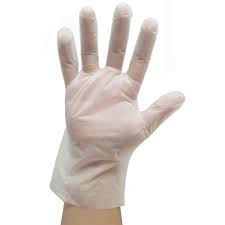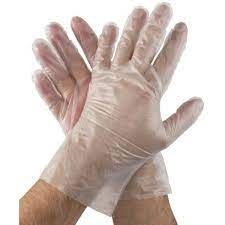2021/07/30 / By hqt / Tags:
What are TPE gloves: Best Material for recyclable gloves?
You think simply rubber medical gloves. But in fact, rubber also has many types with different advantages and disadvantages as TPE gloves. The application lead is also different. Once you understand that, you will know how to choose the right type of glove for each industry

What are TPE gloves?
These gloves are disposable rubber gloves common in medical, surgical, and medical examination to help prevent cross-infection between caregivers and patients. These come from different types of rubber. They may or may not be powdered.
The powder here is cornstarch (corn) to lubricate the gloves, easier to wear. However, in some sensitive jobs, people need not to use powdered medical gloves. Take a look at the rubber glove manufacturing process.
Materials for making TPE gloves
Take a look at 3 basic materials for making TPE gloves
Latex
It is also known as natural rubber (from the rubber tree). Latex has good elasticity, high tear resistance, feels real when holding. However, the puncture resistance and chemical resistance are not as good as other materials. This is the first, most basic type.
Nitrile
Also known as Nitrile rubber stands out for its wear resistance, puncture resistance, and chemical resistance. With its advantages, Nitrile gloves are gradually replacing latex gloves, especially in medical field. The cost of Nitrile medical gloves is about 20% higher than Latex medical gloves (same weight)
vinyl
People use Vinyl medical gloves as a cheap alternative to TPE gloves. However, Vinyl gloves have less elasticity and tear resistance than Latex. Therefore, vinyl gloves are often commonin food, seafood processing, etc.
Pros – Cons
The following table with detailed description will give you a more general overview of these 3 types of gloves
Latex medical gloves (Latex gloves) and Nitrile (Nitrile gloves) are the two most commonly commontypes.
| Materials/Properties | Latex | Nitrile | vinyl | |
| Osmotic | Excellence – the benchmark in waterproofing | Excellent – outstanding puncture and tear resistance. | Poor – Gloves easily puncture and tear. The tightness is poor, so it also reduces the protection area. | |
| Allergy | Depending on the type – Latex contains certain proteins that cause allergic reactions in some people. Powder-free TPE gloves have very little protein content, so the risk of allergies is small. | Very good - Hypoallergenic | Good – Hypoallergenic | |
| Reliability | Excellent – longevity and high elongation. Tensile strength >=3500psi | Excellent – high puncture resistance. Tensile strength >=3000 psi | Weak – Vinyl is a glove with poor physical properties and the worst life of all gloves. The tensile strength is usually just under 2000 psi. | |
| Elasticity, comfort | Excellent – Latex's elasticity surpasses that of other gloves. The ability to maintain the original shape after stretching is also very good. | Very good – The elasticity is quite good. Unlike TPE gloves, nitrile gloves will remember the size of the wearer's hand. | Poor – Vinyl gloves have poor elasticity and this property fluctuates depending on the manufacturer. | |
| Anti-puncture | Very good – Latex gloves are very puncture resistant | Excellent -
Nitrile's puncture resistance is superior to other gloves. |
Least | |
| Chemical resistant | Good – Good resistance to caustics and detergents. | Excellent – Resistant to a wide range of chemicals, especially organic solvents. | Weak – Vinyl is soluble in organic solvents. | |
| Price | Very Good – Powdered TPE gloves are considered the standard of medical gloves. However, the price of powder-free latex gloves is much higher than that of powdered ones. | Good – Nitrile gloves cost more than latex. | Very Good – Same price as latex or less. Is a cheap alternative of latex gloves in case users are allergic to latex proteins. | |
| Application of tpe gloves | It is the choice in the medical field except in cases of allergies. | As an alternative to latex gloves. Especially where high mechanical properties or chemical resistance are required. | Is the low cost alternative of TPE gloves. Not recommended for use in the medical field or where there is a high risk of infection. |
Powdered and non-powdered TPE gloves
To make disassembly easier, more convenient and faster, powdered TPE gloves are available, including nitrile and latex lines. The flour common here is cornstarch. However, studies show that cornstarch helps keep the protein in rubber longer on the surface, increasing the level of skin allergies when used, even dermatitis when the skin is wet or injured.

Not to mention, the use of medical rubber gloves with powder is not recommended in surgery or the food processing and cooking industry because the powder is easily spread out leading to poisoning, affecting health. Therefore, although powder-free TPE gloves do not offer the same quick on and off action as powdered ones, they offer a higher level of safety.
Instructions for wearing – removing medical gloves properly
Put on and take off medical gloves properly so as not to get infected with bacteria. This is one of the rigorous tests, especially for people working in the fields of medicine, food, and medicine. Currently, medical rubber gloves are sold quite a lot at stores, pharmacies or e-commerce sites, consumers can easily choose the right type.
However, to avoid buying poor quality products, don't forget to carefully read the ingredients, types, origin, expiry date... before you buy.
What are protective TPE gloves?
Protective TPE gloves are gloves made of rubber including 100% natural rubber and synthetic rubber, to ensure safety for workers' hands. So these gloves have many types such as household gloves, industrial gloves and nitrile rubber gloves, latex gloves. Household gloves and industrial gloves we've shared in previous articles, please You see: household gloves and industrial gloves
Nitrile rubber gloves made from synthetic rubber have good water and oil resistance, so they are widely used, especially in clean rooms such as anti-static common in electronics, in laboratories. TPE gloves, the main ingredient is natural rubber, which is widely common in the medical, cosmetic and medical industries because of its high hygiene and safety factors.
What are wool safety gloves?
Therefore Protective wool gloves are gloves made from wool yarn woven by machine depending on the number of grams and needles that have different weights. Protective wool gloves help reduces friction and smoothness when working, commonin normal jobs such as construction, gardening, janitors. The price of woolen gloves is also very cheap and sold in many places. Rubber-coated wool gloves are also known as rubber-coated gloves.


